After tackling Random Encounters, I figured it’d be interesting to take a look at the other side of the coin — Field Encounters.
[my_definition title=”Field Encounter”]
A battle transition trigger that’s shown on the map itself.
[/my_definition]
While Random Encounters were a standard in the era of 2D, plenty of games at least experimented with a different approach. Early JRPGs such as Final Fantasy featured some visible NPCs that initiated combat, typically scripted boss encounters.
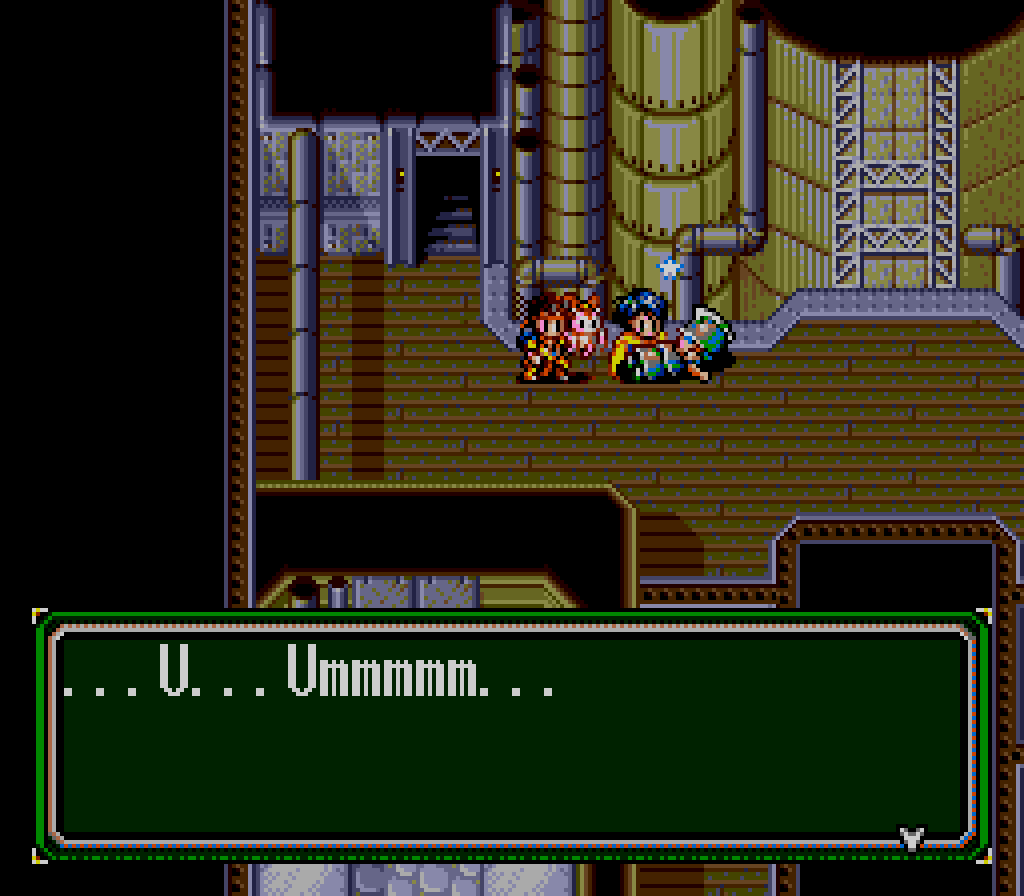
Later on, games like Lufia II used visible monsters in dungeons, while and Pokémon Red/Blue peppered trainer-NPCs between towns that sought to battle the player. Other games still like EarthBound and Chrono Trigger fully leaned into Field Encounters, showing all enemies on maps despite the additional costs.
With the move to 3D, a lot of the technical limitations that necessitated Random Encounters were greatly minimized. Memory constraints became less crippling and enemy models could be used both in the field and in battles.
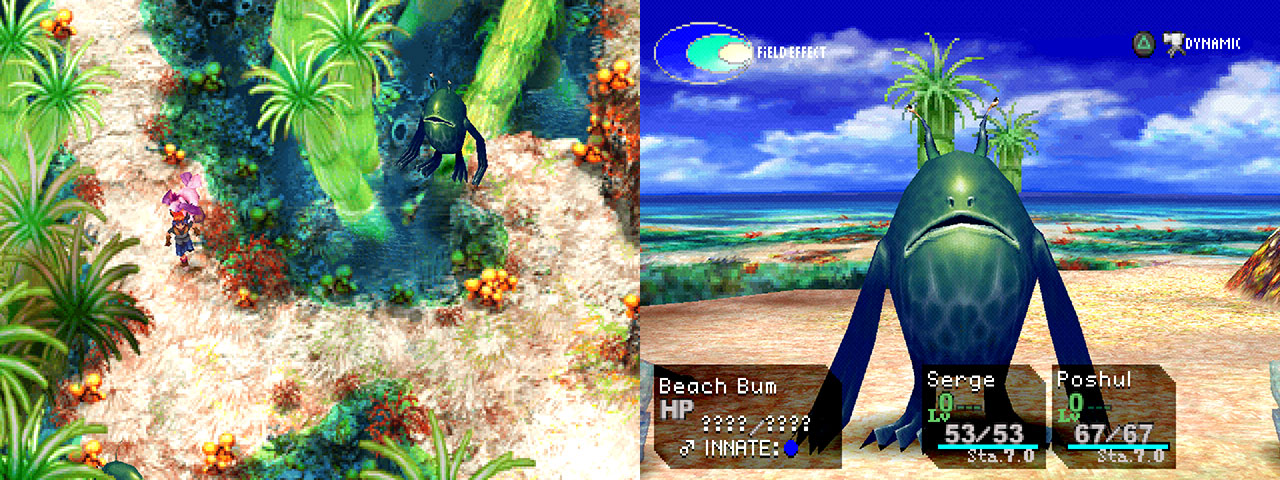
This evolution went down various paths — including some series transitioning to mostly real-time, in-map combat systems — but I’ll stay focused on titles that remained largely analogous to those with Random Encounters.
In order to implement Field Encounters, a variety of elements need to be considered:
- Spawning – Rulesets that dictate the way in which enemies appear on the map.
- Visualization – How the enemies and enemy indicators are shown.
- Behaviour – Custom actions of enemies prior to battle.
- Interactions – Elements that affect on-screen enemies and subsequent combat.
As with Random Encounters, I also appended each category with some brainstorming for unexplored approaches.
Spawning

- Predefined – Enemies are placed at specific points on the map. The type of enemy can be static or semi-randomized.
- Proximity – As the player gets close to a spawnpoint, random enemies appear on or around it. When the player retreats or the enemies go offscreen, they’re typically despawned.

- Scripted – Each appearance of an enemy requires a custom trigger or a hand crafted entrance akin to Pen & Paper encounters, e.g., a group of human NPCs transform into monsters in Chrono Trigger when the player tries to leave the room.
- Timed – New enemies appear at specific spots on the map based on a real-time countdown or an amount of steps the player has taken.
[my_ideas]
- A progression where all initial spawnpoints are used only once, and are replaced by different spawnpoints upon subsequent visits to create different traversal/combat challenges.
- Enemies spawn continuously offscreen as the player moves around. Caps limit the total amount of enemies, while map sectors dictate which enemies can appear in different parts of the map.
- Spawn points only activate via a global countdown that decrements with player actions such as fighting battles or transitioning to different maps. This can create a feeling where maps get depopulated but eventually resettled, making exploration easier but grinding still possible.
[/my_ideas]
Visualization

- Abstract – A solitary, nondescript visual — such as a shadow in Persona 3 — that represents all enemies that will appear in battle.
- Singular – An enemy is fully recognizable in the field, but other foes that are not shown might join it once combat begins.
- Grouped – Only the enemies present in the field will appear in battle.

- Concealed – Enemies are present in the field, but not immediately visible. They can be hidden by their surroundings or disguised as actual environmental objects.
In addition to the above, field enemies tend to use animations and overhead icons to indicate their behavioural state. For example, enemies in Lunar: Silver Star Story Complete use a unique chase animation when pursuing the player, while enemies in Radiant Historia display a dizzy icon when weakened.

Auras, glows, and highlights can also indicate a particularly strong enemy or rare encounter, e.g., the red and blue auras in Pokémon: Let’s Go, Pikachu! represent big and small creature variants respectively.

[my_ideas]
- Display the enemies’ awareness radius/cone, a la stealth games, to help navigate around them or ambush them from behind.
- Append enemy icons to abstract shapes in order to indicate which enemy they represent. Additionally, hint at all enemies that will be fought via additional icons/numbers.
- Use ground trails or enemy icons floating around the perimeter of the screen to indicate offscreen dangers.
[/my_ideas]
Behaviour

The simplest and most common behaviour of Field Enemies is to chase the player once they’re spotted, and to initiate combat when contact is made. However, more nuanced actions can be implemented with field-specific properties such as:
- Movement Type – Does the enemy move along a predefined path, or is their movement randomized?
- Movement Speed – Enemy’s default map-movement speed. Setting it to 0 can ensure some random turning without ever chasing the player.
- Movement Restrictions – Does the enemy respect standard collisions (bird and ghost enemies typically don’t), or is it limited to traversing only a small subset of the map?
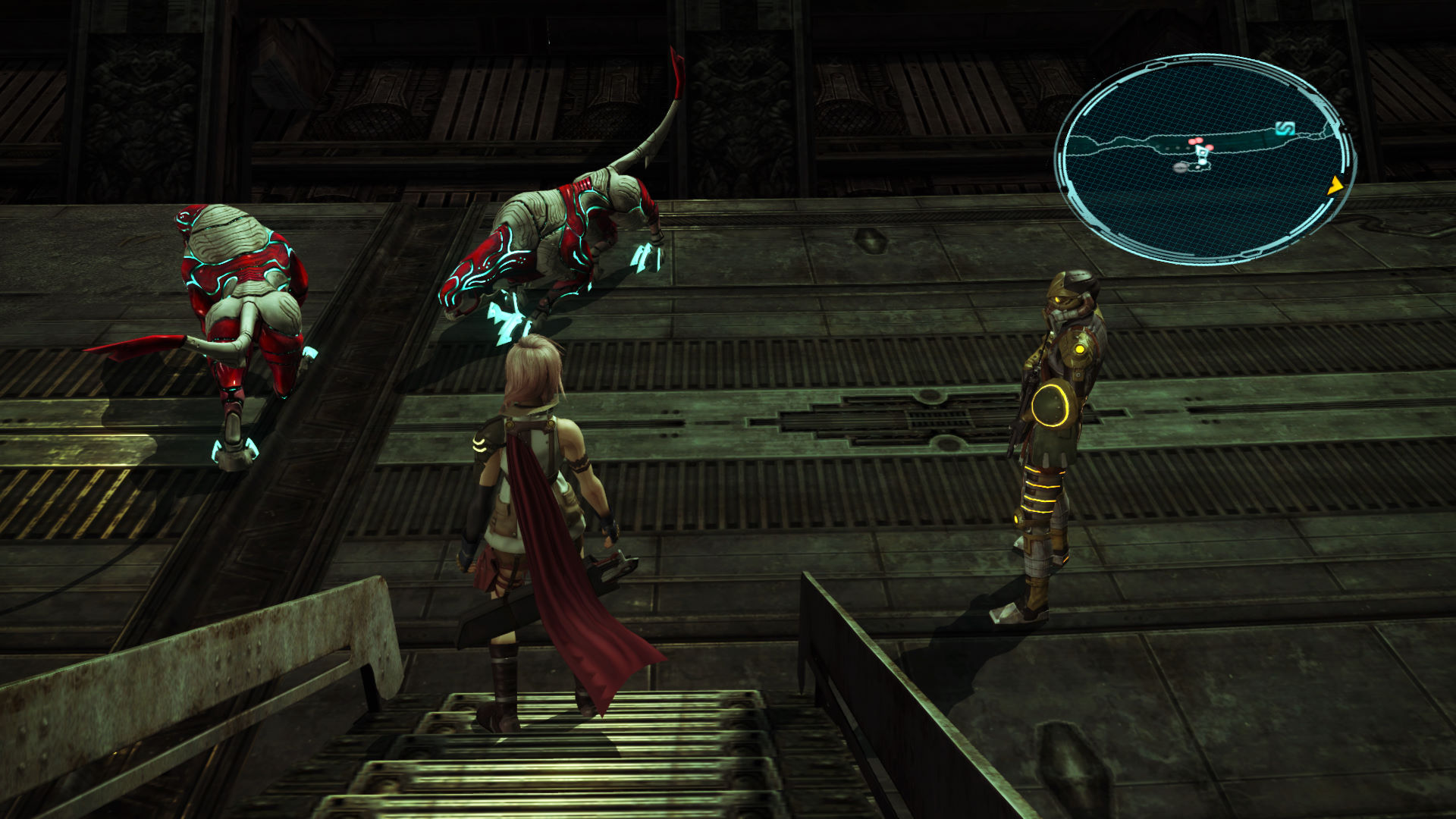
- Chase Speed – Velocity at which the enemy chases the player once they’re spotted. A value higher than the player’s can make Field Encounters difficult to avoid, while a lower value lets players kite enemies and avoid combat.
- Vision Cone – Angle that partially dictates the size of the enemy’s awareness zone. Setting it to a low value creates a thin line that’s easy to avoid, while setting it to 360 degrees creates a full circle around the enemy and makes it impossible to sneak up on it.
- Awareness Range – Effective length of the Vision Cone. A high value will let the enemy spot the player from far away, while setting it to 0 will prevent the enemy from ever initiating combat. This is sometimes done to enemies that are opt-in only, requiring the player to interact with them to enter a battle.
- State Timer – Duration of various logical states, such as how long the enemy will chase the player before giving up.
Combined with a basic State Machine, these properties can be used to create distinct and varied field-enemies. Some examples:
A human sentry slowly patrols between two points in front of a courtyard gate. His vision cone is long but narrow so he only sees what he faces, and a state timer provides a grace period during which a spotted player can get away without raising an alarm. If fully detected, the sentry quickly dives at the player, but needs some time to recover if he misses. If the player leads him too far from the gate, the guard’s movement restriction kicks in and he returns to his post.
Conversely, a guard dog stands still in one location with a short awareness range, as if sleeping, but with a full circle for its vision cone so that it can “smell/hear” the player from any direction. If alerted, the dog continuously homes in on the player’s location, never slowing or stopping, and sprints at a higher speed than the player. Due to no movement restrictions or chase time limits, the dog continues to pursue the player until it is fought or the map is exited.
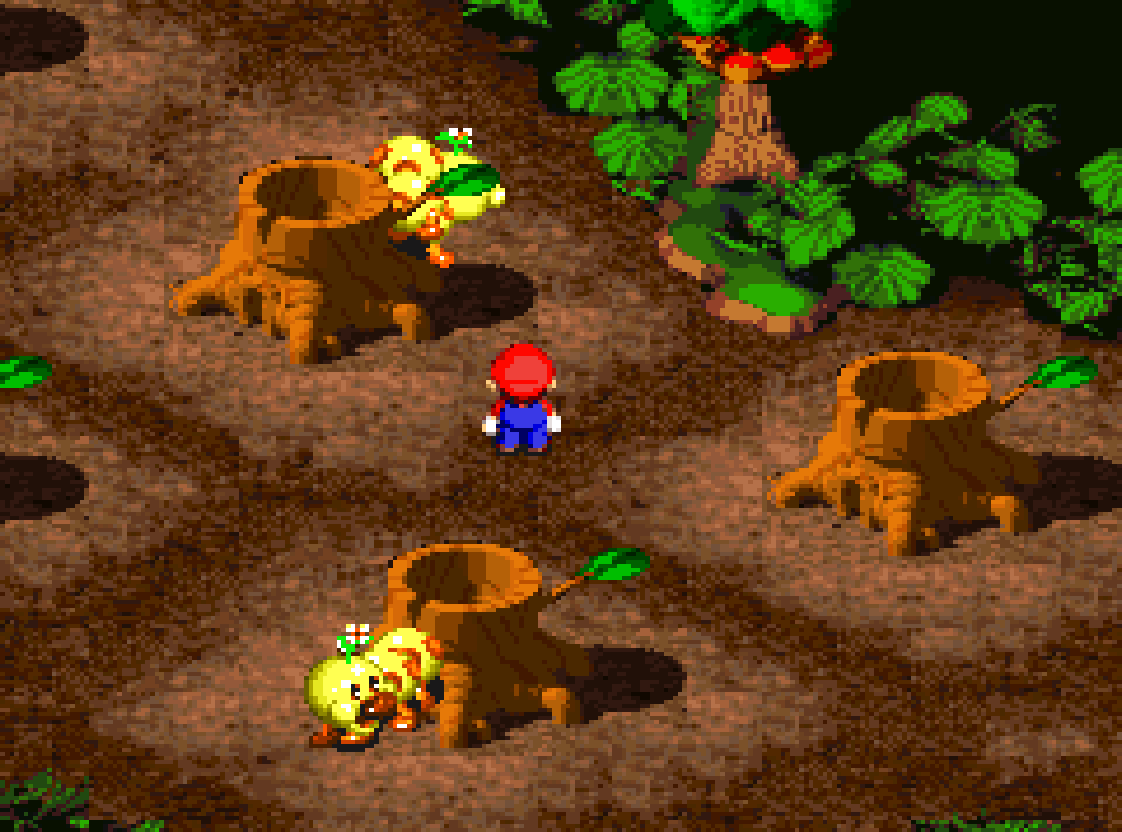
While it would be easy to emulate the state-based behaviours present in platformers and action-RPGs, there’s a risk in putting too much focus on real-time challenges. Such an approach can diminish the importance of the actual battle system and alienate those looking to avoid dexterity-based gameplay.
Chrono Cross partially avoids the issue by scripting a variety of unique encounters: boulders can be rolled to block Komodo Pups from running away, PortalGheists disguise themselves as regular doors and can be used as such but only when their demonic periodically cycles away, various Viper Manor guards rush out when the player steps out onto a lit red carpet, etc.
Finally, on top of individual behaviour, global systems can further impact gameplay:
- Roguelike movement only allows enemies to move when the player moves. Extra delays between movement, different amounts of steps per move, etc., can add further variety.
- Close-by enemies rush in to join the fight once combat is initiated via a touch event. These enemies can join the fight directly, or present subsequent “waves” of enemies, like in Alliance Alive.
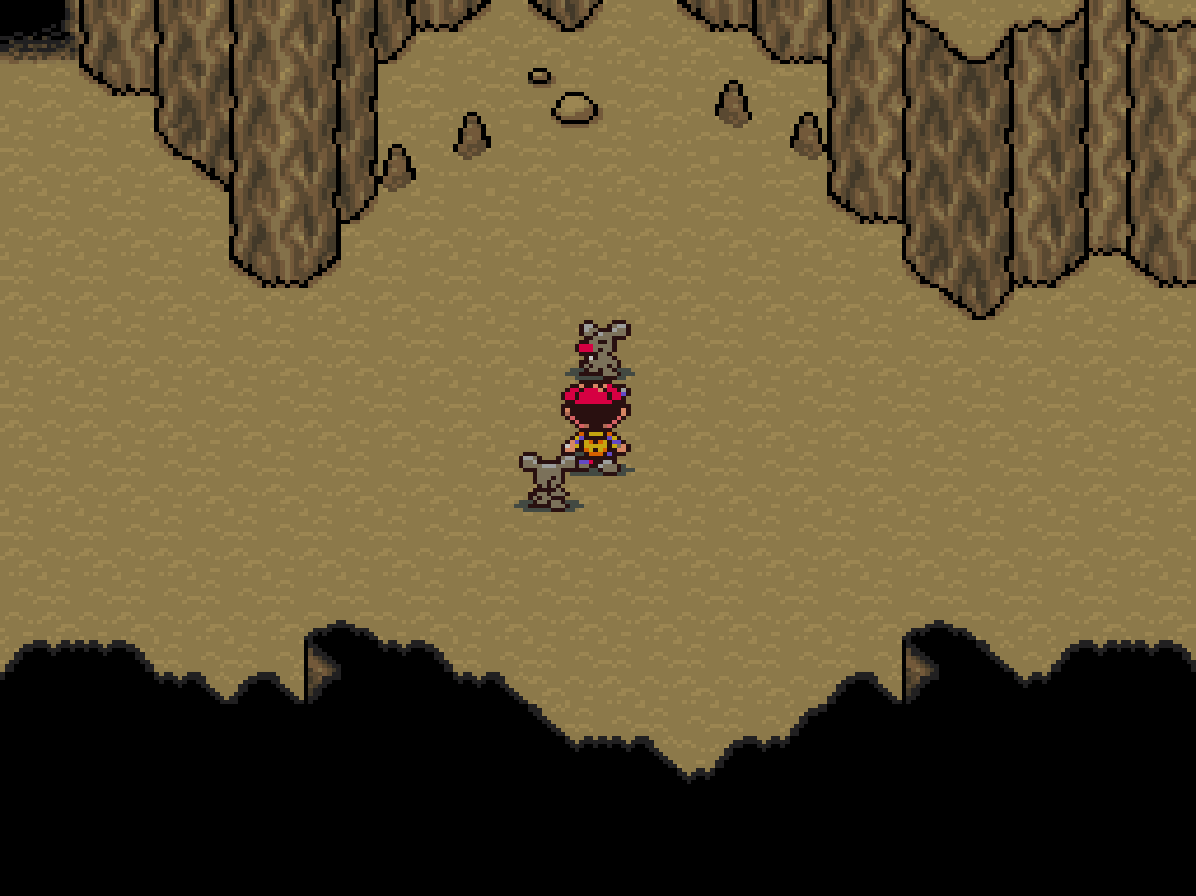
- Level-checks override behaviour, typically making lower-level enemies run away from the player. Repel-style items can also trigger this behaviour.
- Running away from battle provides a grace period for the player to get away without despawning any enemies. To prevent endless loops of combat, the enemy fled from enters a stunned state and doesn’t move/initiate combat for a short period of time.
[my_ideas]
- Provide more interesting behaviour for alerted enemies, e.g., summon allies, raise an alarm, put up a protective barrier, etc.
- Integrate enemies into the environment by allowing them to bust through destructible objects, fall off collapsible bridges, get slowed down or trapped by quicksand, chase and fight each other, etc.
- When the player escapes from battle, bring them to where they entered the map, or where they last defeated an enemy, to prevent traversal exploits while adding some cost to running away.
[/my_ideas]
Interactions
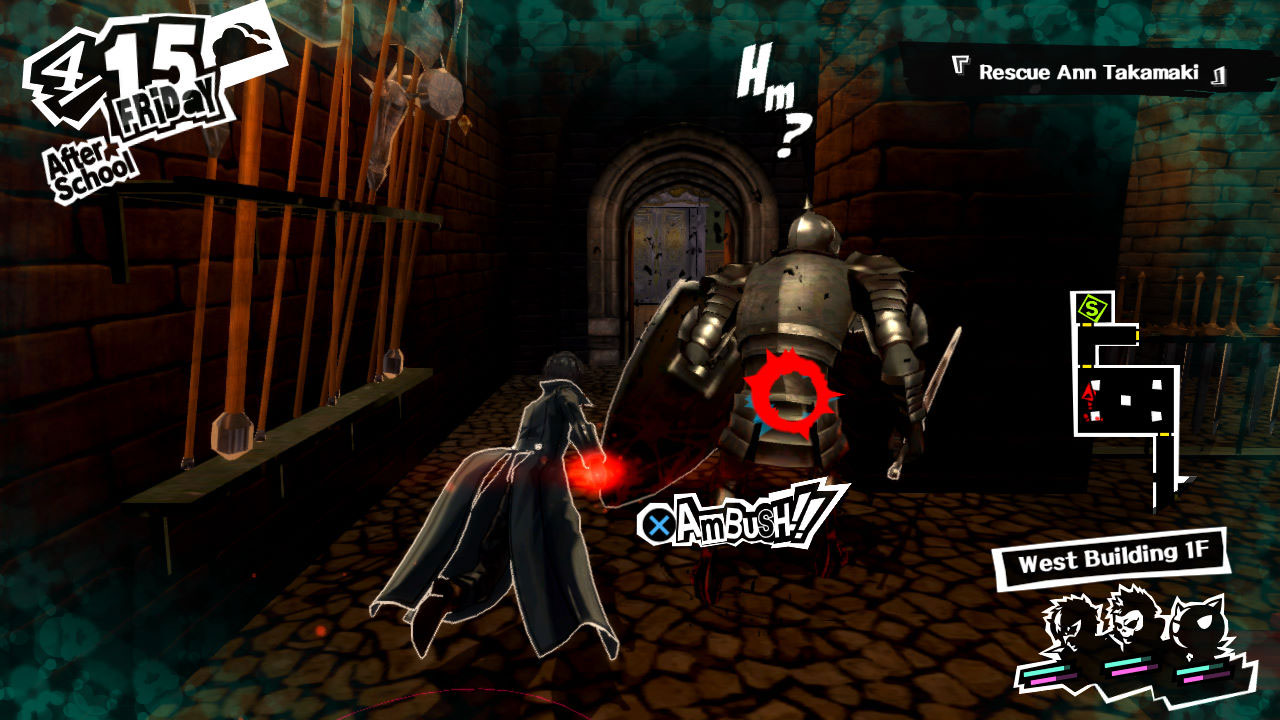
The main interaction with in-field enemies is starting actual combat, which is commonly initiated in three different ways:
- Vicinity – The player moves into a trigger zone for an enemy or a group of enemies.

- Contact – The player and the enemy physically touch. If one entity touches the other from behind, some sort of advantage is often given. In games with in-field followers, enemies typically don’t collide with the followers to limit frustrations.
- Attack – The player hits the enemy with a manual attack. This can initiate combat right away, or make the enemy go into a stunned state allowing the player to run past them. Stun-states can come in various categories as well, dictating stun duration and what type of advantage is given, e.g., in the original Trails games, attacking enemies from behind stuns them for a long time while leaving the option to engage them with advantage, but hitting them from the front only stuns them briefly and provides no major advantage.

Combat advantage typically manifests as a speed-bonus/free turns, giving a distinct upper hand to the aggressor. Aside from jockeying for advantage, other in-field interactions also include:
- Manually sucking in multiple nearby enemies in Blue Dragon to gain greater rewards and cause some enemies to fight each other.
- Auto-defeat enemies upon contact via a Starman powerup in Super Mario RPG, or when the enemy is vastly underleveled relative to the player in EarthBound. Enemies defeated in this fashion still grant their regular rewards.
- Script custom behaviour upon a successful attack, such as guards being knocked in Chrono Trigger’s prison sequence.
[my_ideas]
- Make better use of environmental interactions: assign a “loudness” score to different surfaces to vary how enemies are alerted, provide cover spots to more easily ambush enemies regardless of facing direction, use manually activated traps to hobble or destroy enemies, etc.
- Use skills or items to stun enemies, afflict them with status effects like poison, debuff their stats, etc. These interactions should pause movement to avoid becoming dexterity-based skillshots.
- Provide new types of advantage with various ways to gain it, e.g., launching a debuff spell from afar decreased the speed of all enemies for the duration of the battle, while ambushing them makes all initial attacks from the player’s party auto-crit.
[/my_ideas]
Field Encounters have become a standard in JRPGs — even re-releases of classics such as Dragon Quest VIII embrace the system over Random Encounters.

Fans seem to have largely embraced the trend, often citing the ability to avoid enemies as a positive development. However, this claim seems to be at least slightly exaggerated. Enemies in the field can move faster than the player, approach from multiple directions, clog up narrow dungeon corridors, and have countless other variables weighed in their favour to force combat.
More accurately, the main advantage of Field Encounters — aside from being inherently less abstract — is a greater sense of player agency. Being able to anticipate an encounter, heal up for it, change party members or equipment, and manually initiate the battle can make for a much more deliberate experience.

The flipside of this is that Field Encounters can hamper exploration. Going down each path of a forked road is a lot less enticing when both routes are filled with enemies. Juking past them — if possible — just to see if there’s something worthwhile on the other end can get quite tedious, if not downright stressful.
If you know of any titles that alleviate this issue (if not solve it), leave a comment below. And if not, simply share your favourite implementations of Field Encounters and what made them so enjoyable!
I don’t mind the more actiony elements of field encounters. They give something to do while exploring, and I like the extra bonuses advantage can provide. When they’re not there it just feels like it doesn’t matter how enemies are interacted with.
I get it, and the dexterity-based stuff is something of a spectrum. I’m personally a fan of the timed elements in the Mario RPGs and the Judgement Ring in Shadow Hearts, but they’re not for everyone. As was pointed out to me, Kuro no Kiseki goes even further in the action direction, but the focus on real-time combat has been divisive: https://www.reddit.com/r/Falcom/comments/u5xh32/after_hajimaris_amazing_gameplay_kuro_feels_like/
Regardless of where a JRPG lands on the dexterity-spectrum, implementing enemy-based field mechanics will always have an impact on exploration. Conversely, I think there’s room for new exploration mechanics to fill the gap without requiring twitch-gameplay.
For what it’s worth I find random encounters a bit more relaxing. I like exploring without having to worry about outrunning enemies or getting advantage while doing it.
It’s certainly a different vibe. Random Encounters are a global element that’s relatively separated from the environment, while Field Encounters require constant scanning/avoiding/interacting with enemies as part of that environment.
I don’t know if I have a clear preference myself — both approaches have their pro’s and con’s — but I get why others have a clear favourite.